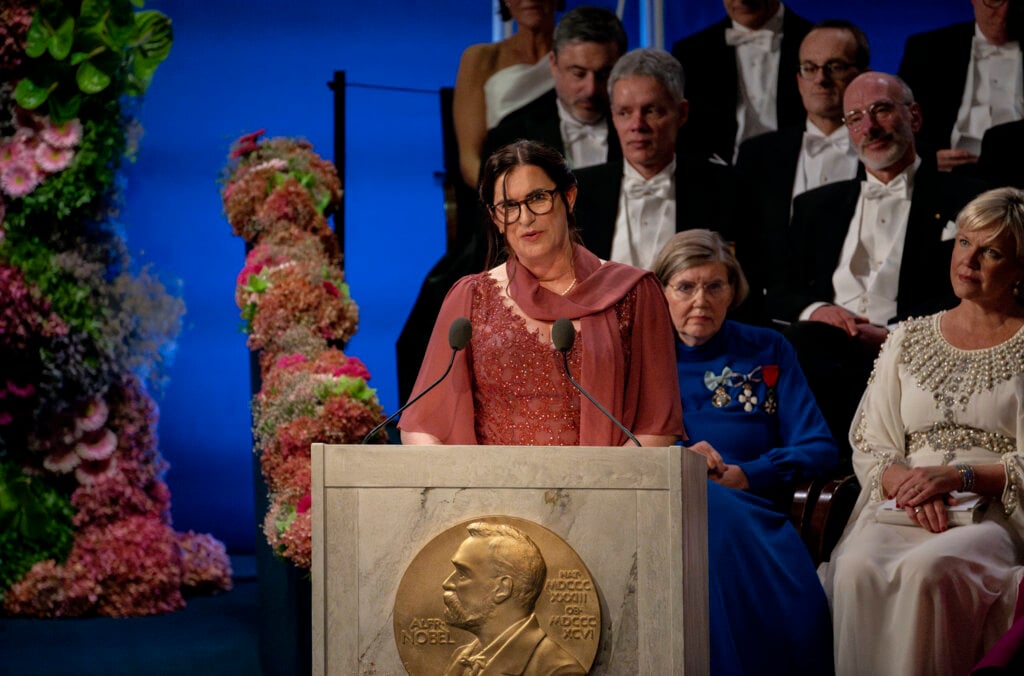Award ceremony speech

English
Swedish
Presentation speech by Professor Ellen Moons, Member of the Royal Swedish Academy of Sciences, Chair of the Nobel Committee for Physics, 10 December 2024.
Your Majesties, Your Royal Highnesses, Esteemed Nobel Prize Laureates, Ladies and Gentlemen,
As you arrived here today, you recognised some faces instantly and names came to you in a flash. Other names may have slipped your mind. Perhaps you felt a twinge of frustration, scanning your memory for the circumstances of past encounters that just won’t come into focus.
Memory association works as a scaffold to understand new information. With every thought, the billions of neurons in our brain develop stronger connections. In 1949, the Canadian psychologist Donald Hebb said, “neurons that fire together, wire together”, to describe the mechanism of learning.
This year’s Nobel Prize laureates in physics, John Hopfield and Geoffrey Hinton, were inspired by the network of neurons in the human brain. They developed artificial neural networks, which are fundamental for machine learning – allowing computers to learn without explicit programming.
In 1982, John Hopfield discovered that the physics describing how atomic magnetic moments align in solids, giving them their magnetic properties, can also be used to describe interactions between neurons in our brains. He developed a dynamical model for an associative memory, based on networks of binary nodes, where nodes were assigned values determined by a weighted sum over all nodes.
Like a ball rolling down a hill, the dynamics drive the system into the valleys of the energy landscape, where it relaxes. In these valleys, memories are located as stationary states. So, this is where you will find the name of the acquaintance you were searching for in your memory landscape!
As a theoretical physicist with deep roots in solid state physics and a passion for complex processes in biophysics and neuroscience, John Hopfield’s achievements are a testimony to the power of interdisciplinary thinking.
Geoffrey Hinton extended Hopfield’s model, using ideas from statistical physics. The invention is called the Boltzmann machine, named after the Austrian physicist Ludwig Boltzmann. It contains multiple layers of nodes and is trained using given sets of patterns. Once trained, the network can generate new patterns that resemble those in the learned set.
Geoffrey Hinton is a leading figure in the development of efficient learning algorithms. He pioneered the efforts to establish deep and dense neural networks. Such networks are effective in sorting and interpreting large amounts of data and self-improve based on the accuracy of the result.
Today, artificial neural networks are powerful tools in research fields spanning physics, chemistry and medicine, as well as in daily life. While they can aid humans in delivering fast answers, it is our collective responsibility to ensure that they are used in a safe and ethical way.
Professor John Hopfield and Professor Geoffrey Hinton, you have been awarded the 2024 Nobel Prize in Physics “for foundational discoveries and inventions that enable machine learning with artificial neural networks.” It is an honour and a privilege to convey to you, on behalf of the Royal Swedish Academy of Sciences, our warmest congratulations.
I now ask you to step forward to receive your Nobel Prizes from the hands of His Majesty the King.
Copyright © The Nobel Foundation 2024
Nobel Prizes and laureates
Six prizes were awarded for achievements that have conferred the greatest benefit to humankind. The 12 laureates' work and discoveries range from proteins' structures and machine learning to fighting for a world free of nuclear weapons.
See them all presented here.
